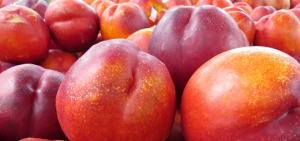Nectar of the Gods

Geri Wohl, CNC
Better Eating Coach
Written By: Geri Wohl, CNC
www.bettereatingcoach.com
The temperatures are rising and summer is upon us. Fortunately, that means that fruits like nectarines and peaches are ripening and becoming abundant at the market. Not surprising, nectarines and peaches are in fact from the same family. The only genetic difference between the two is the expression of one recessive gene. We see this gene expression as the smooth skin in the nectarine instead of the fuzzy covering found on peaches. In addition, nectarines are usually smaller, more aromatic and contain more red tones on their skin.
The word nectarine is derived from the Greek “nekter.” In Greek mythology, nekter was believed to impart immortality. However, peaches and nectarines originated in China more than 2,000 years ago before being cultivated in Persia, Greece and Rome. California farms grow over 150 varieties of nectarine, producing over 95% of the US crop. Nectarines are typically firmer and sweeter than peaches. So treat yourself to some of the different varieties and enjoy the nuances of flavor.
Due to their similar genes, their nutritional profiles are also similar. Nectarines are low in calories; 1 medium size nectarine is about 60 calories. Nectarines are low in fat and have no cholesterol or sodium so beneficial for those concerned about sodium content or managing their heart health. Nectarines are a rich source of vitamins A, C and K, dietary fiber and potassium. Furthermore, due to the low calories, fiber content and energy used to digest them, nectarines fill you up and can aid in weight loss. They also contain vitamin E, B vitamins, calcium and iron. For more info about peaches and stone fruits, see my article, “A Peach A Day.” Be aware that nectarines do contain sugar but are ranked on the lower end of the glycemic index.
While nectarines and peaches may be freestone or clingstone, most people choose based on their preferred flavor and color. Yellow nectarines and peaches have more acid, which competes with the natural sugars and gives the fruit a more tangy taste. The white nectarines and peaches are classified as sub acid resulting in a mellower and sweeter flavor. Your taste buds will be the best judge of which you prefer.
The skin of nectarines is a great source of antioxidants. Just as our skin is designed to protect us from external assaults, the phytonutrients on the exterior of produce are a defense mechanism for the plant. By eating these phytonutrients, which are antioxidants, we obtain these benefits. A simple rule of thumb, the deeper the color of a fruit or vegetable, the more antioxidants it contains. Antioxidants are believed to protect our bodies by capturing and ridding us of free radicals, which cause cellular damage and possibly contribute to disease and aging. Beta-carotene, one of the antioxidants found in nectarines, is believed to help protect the skin against certain cancers possibly by reducing oxidation caused by UV light and other environmental toxins. Nectarines also contain lutein and lycopene; antioxidants currently being studied for their support in eye health, particularly preventing macular degeneration and cataracts. So make sure you eat the skin as well.
 The flesh of the nectarine also contains antioxidants albeit in lower quantities than the skin. The yellow flesh varieties have higher levels of carotenoids since these antioxidants are responsible for the yellow/orange coloration of produce. The carotenoids are converted to vitamin A, providing support for the immune system, vision and normal growth. The white-fleshed nectarines, on the other hand, typically have higher amounts of ascorbic acid, also known as vitamin C. Overall, both yellow and white nectarines are about comparable in antioxidant capacity, but with variations in the specific antioxidants found in each.
The flesh of the nectarine also contains antioxidants albeit in lower quantities than the skin. The yellow flesh varieties have higher levels of carotenoids since these antioxidants are responsible for the yellow/orange coloration of produce. The carotenoids are converted to vitamin A, providing support for the immune system, vision and normal growth. The white-fleshed nectarines, on the other hand, typically have higher amounts of ascorbic acid, also known as vitamin C. Overall, both yellow and white nectarines are about comparable in antioxidant capacity, but with variations in the specific antioxidants found in each.
In addition, nectarines are full of vitamin C. One nectarine contains about 12% of the RDA for vitamin C. During the 16th and 17th century, as explorers and sailors developed scurvy, doctors realized the importance of vitamin C in the diet. Fortunately, we now have plentiful resources to obtain vitamin C-rich foods. So what else does vitamin C do for us?
- It provides immune system support. While vitamin C may not prevent a cold, it does seem that it can reduce the length of sickness and have us back on our feet in a shorter time.
- Vitamin C may protect against cardiac disease by reducing our risk of plaque buildup in our arteries as well as keeping our arteries and veins pliable.
- Vitamin C is essential for collagen formation; the main structural protein found throughout the body. Collagen is found in bone, cartilage, skin and blood vessel walls. It also helps our skin have good elasticity.
- Vitamin C helps to repair wounds more quickly. For those having surgery, having more vitamin C may shorten recovery time. (Ask your doctor before self-treating with increased vitamin C.)
- As an anti-oxidant, it can neutralize oxidized vitamin E and render it back to its beneficial antioxidant state.
- Vitamin C is a co-factor in the absorption of iron, necessary for the synthesis of red blood cells and other metabolic functions.
- Vitamin C is essential for supporting the adrenals, the glands responsible for our stress response.
Vitamin C is a water-soluble vitamin. As such, it cannot be stored in the body. Any extra vitamin C is excreted. We are one of the few animals that cannot manufacture our own vitamin C. Thus, we must obtain it from our food. According to Dr. Andrew Weil, the body can utilize up to 250 mg of vitamin C per day if needed. Vitamin C is very sensitive to heat and oxygen. Fruits and vegetables containing vitamin C will begin losing the vitamin as soon as the produce is cut. To maximize your intake of vitamin C, use the food quickly and eat it in its raw state as much as possible. If cooking is required, try to use as little heat and shorter cooking times. While raw is best, if cooking is required, steaming is the preferred method to retain as many nutrients as possible.
Nectarines and peaches are fruits that are heavily sprayed with pesticides. Try to buy organic if possible. If buying conventionally, wash off the pesticides. For advice on washing pesticides, see my article, “A Peach A Day.” Or buy these stone fruits labeled with CCGA (California Clean Growers Association). For info about their unique farming practices, see my article, “Stone Fruit Straight From the Farm.”
Nectarines and peaches can be used interchangeably. Enjoy these wonders of the season. They are a great snack raw, sliced uncooked (just before using) on a salad, as a complement to chicken and make a great dessert. For a delicious dessert, try my Blueberry Peach Crisp (but with nectarines). Enjoy these juicy fruits with all their benefits!
© Geri Wohl, CNC









